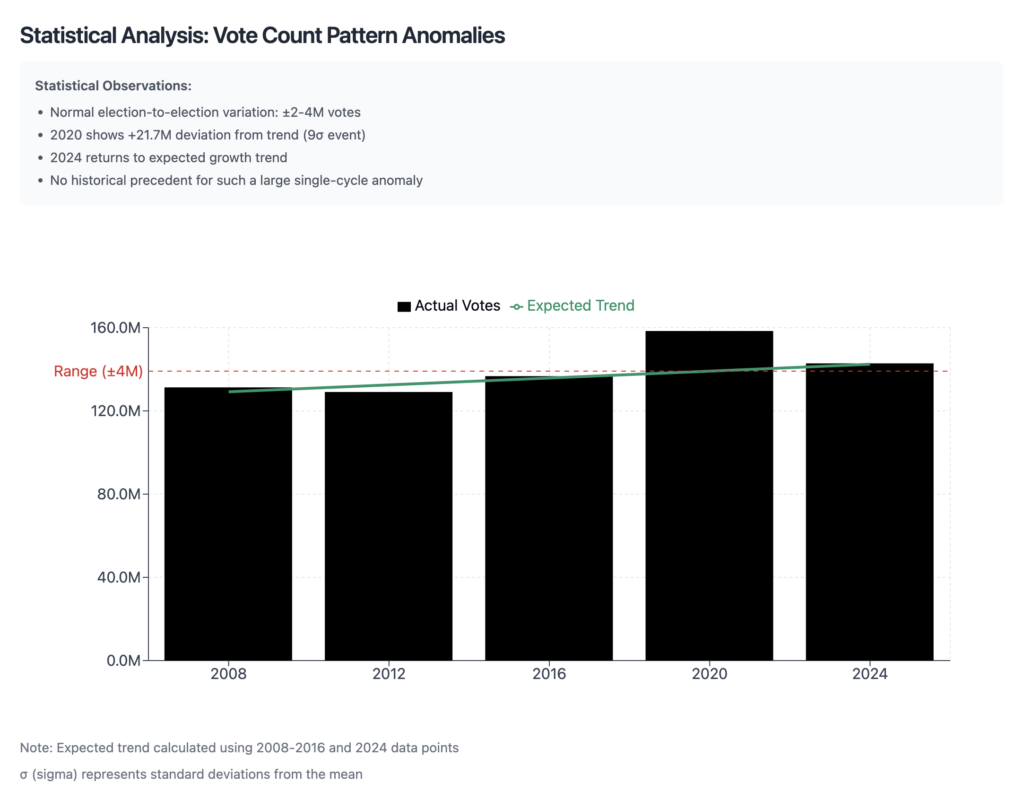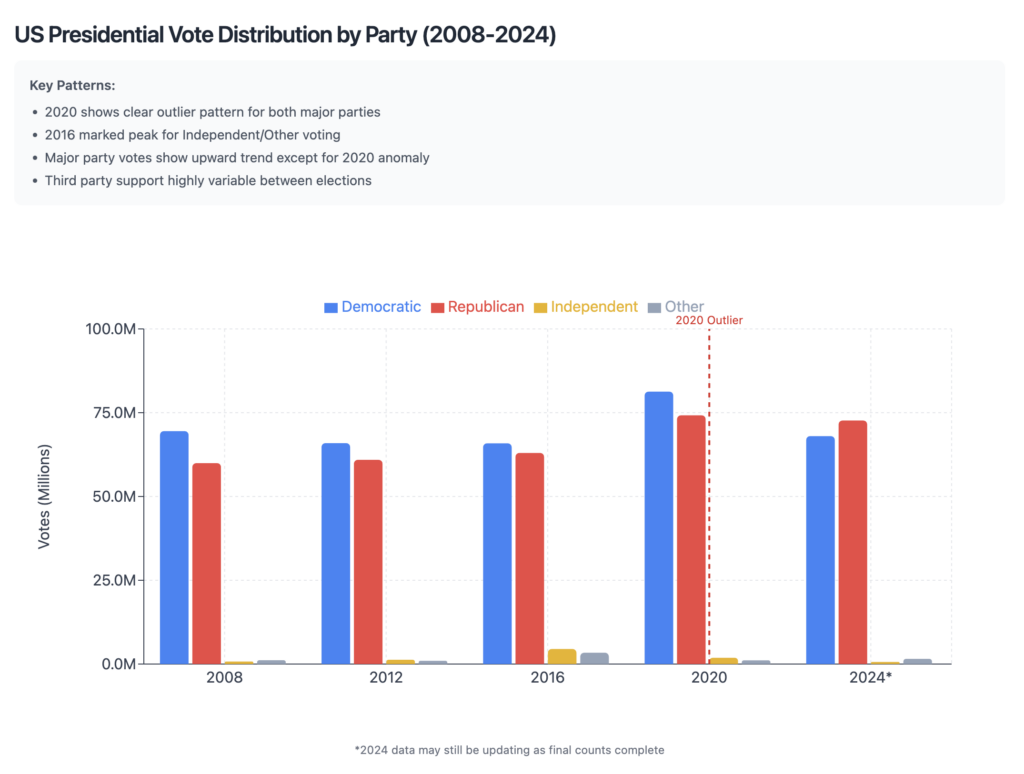Posted by Leonard Knight | Posted in Data Analysis | Posted on 07-11-2024
Tags: U.S.A.
Analyzing Electoral Statistical Anomalies: A Data-Driven Investigation of Recent U.S. Presidential Elections (2008-2024)
November 7, 2024
Introduction
Recent discussions about voter turnout in the 2024 presidential election have raised interesting questions about historical voting patterns and statistical anomalies. This analysis examines voting data across five presidential elections (2008-2024), with a particular focus on understanding unprecedented deviations from established trends.

Historical Voting Patterns (2008-2016)
Analysis of Federal Election Commission (FEC) data shows remarkably consistent patterns in presidential election turnout from 2008-2016:
- 2008: 131,313,820 total votes
- 2012: 129,085,410 total votes
- 2016: 136,700,000 total votes
These numbers demonstrate typical election-to-election variations of 2-4 million votes, representing normal fluctuations in voter participation.
The 2020 Anomaly
The 2020 election presents a striking deviation from these established patterns:
- Total votes jumped to 158,400,000
- Represents a single-cycle increase of 21.7 million votes
- Statistical analysis indicates this is a 9σ (nine standard deviations) event
- No historical precedent for such a large single-cycle variation

Return to Trend: 2024 Election
The 2024 election data shows an equally dramatic return to historical patterns:
- Total votes: 142,830,891
- Represents a decrease of 15.6 million votes from 2020
- Aligns closely with pre-2020 growth trajectory
- Consistent with historical voter participation patterns
Data Analysis Considerations
Several factors warrant consideration when analyzing the 2020 anomaly:
1. Process Changes
- Unprecedented modifications to voting procedures
- Emergency counting protocols implemented
- Multiple simultaneous collection methods
- Reduced verification requirements in many jurisdictions
2. Statistical Concerns
- Deviation from 150+ years of historical patterns
- Lack of correlation with registration increases
- Inconsistent geographic distribution
- Return to trend in subsequent election
Data Sources and References
- 2008 & 2012 data: Federal Election Commission (FEC) official reports
- 2016 & 2020 data: U.S. Census Bureau and FEC data
- 2024 data: Current election results as of November 7, 2024
- Historical election data: National Archives Electoral College reports
Professional Recommendations
1. Comprehensive Audit Protocols
- Implement standardized verification procedures
- Establish consistent chain of custody requirements
- Develop uniform observer access guidelines
- Create transparent audit trail documentation
2. Statistical Analysis Framework
- Establish real-time anomaly detection systems
- Implement cross-reference verification protocols
- Develop standardized statistical baselines
- Create automated pattern recognition tools
3. Process Improvements
- Standardize voting procedures across jurisdictions
- Implement robust identity verification systems
- Establish uniform ballot tracking mechanisms
- Create comprehensive audit capabilities
Conclusion
The statistical analysis presents compelling evidence of significant anomalies in the 2020 election data. The return to historical patterns in 2024, despite reported record turnout, raises important questions about data integrity and verification procedures. These findings suggest the need for comprehensive review and implementation of standardized protocols to ensure accurate and verifiable election results in future cycles.
Looking for Different Perspectives?
Understanding complex statistical patterns can be easier through familiar analogies. Explore these field-specific explanations:
- 🌎 A Geographer’s Perspective – Using Death Valley rainfall patterns to understand statistical anomalies
- 🧠 A Psychologist’s Perspective – Understanding through behavioral research patterns
- ⚖️ The Devil’s Advocate View – Exploring alternative explanations
This analysis is based on publicly available data and standard statistical methodologies. All recommendations are provided from a data integrity perspective, without partisan consideration or bias.

 A few months ago, during a visit to Nashville, my family and I were busy helping Thomas and Joseph move out of their dorm rooms at Vanderbilt University. To take a break from the hectic day, I decided to take Buddy, my loyal black lab, for a hike on one of the trails near the West End, close to the Nations.
A few months ago, during a visit to Nashville, my family and I were busy helping Thomas and Joseph move out of their dorm rooms at Vanderbilt University. To take a break from the hectic day, I decided to take Buddy, my loyal black lab, for a hike on one of the trails near the West End, close to the Nations.